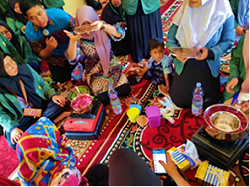Pemanfaatan Bahan Alam sebagai Sumber Daya Kosmetik untuk Perawatan di Kelurahan Sungai Tiung Kecamatan Cempaka Utilization of Natural Materials as Cosmetic Resources for Treatment in Sungai Tiung Village, Cempaka District
Main Article Content
Abstract
Today, many cosmetic products are unhealthy and un-quality. Nowadays, the lifestyle trend of "back to nature" is increasing where people's trust in active compounds of natural materials is relatively safer than synthetic chemical compounds. Therefore, creating healthy and quality products at affordable prices is the focus of the government. Cosmetics are ingredients or preparations intended for use on the outside of the human body (epidermis, hair, nails, lips, and outer genital organs) or teeth and mucous membranes of the mouth, especially to cleanse, scent, change the appearance, and or improve body odor or protect or maintain the body in good condition. The activities that will be carried out are a demonstration of the manufacture of cosmetics of natural materials by a team of lecturers to the community in The Village of Sungai Tiung, Cempaka, Banjarbaru to improve the quality of public health knowledge and insights towards the training of cosmetic natural materials so that people can use the natural ingredients around as cosmetics and have a selling value, such as rose water, masks, and body butter. So that the cosmetic natural ingredients have the potential to be developed into natural mask ingredients for the face. It is expected that residents can use coffee, green tea, rose petals, oats, and rice as natural cosmetic ingredients for treatment and can increase their economic value as a business opportunity.
Downloads
Article Details
Authors who publish with this journal agree to the following terms:
- Any article on the copyright is retained by the author(s).
- Author grant the journal, right of first publication with the work simultaneously licensed under a Creative Commons Attribution License that allows others to share work with acknowledgment of the work authors and initial publications in this journal.
- Authors are able to enter into a separate, additional contractual arrangements for non-exclusive distribution of published articles of work (eg, post-institutional repository) or publish it in a book, with acknowledgment of its initial publication in this journal.
- Authors are permitted and encouraged to post their work online (e.g., in institutional repositories or on their websites) prior to and during the submission process, as can lead to productive exchanges, as well as earlier and greater citation of published work.
- The article and any associated published material is distributed under the Creative Commons Attribution-ShareAlike 4.0 International License
References
Chakuton, K., Puangpronpitag, D., Nakornriab, M. 2012. Phytochemical Content and Antioxidant Activity of Colored and Non-colored Thai Rice Cultivars. Asian Journal of Plant Sciences. 11(6):285-293. https://dx.doi.org/10.3923/ajps.2012.285.293
Forester, S.C., Lambert, J.D. 2011. Antioxidant effects of green tea. Molecular Nutrition and Food Research. 55(6):844-854. https://dx.doi.org/10.1002/mnfr.201000641
Haryanto, J.T. 2012. Fenomena Perkawinan Di Bawah Umur (Studi Kasus pada Masyarakat Cempaka Banjarbaru Kalimantan Selatan). Analisa. 19(1):1-14.
Indriaty, S., Hidayati, N.R., Bachtiar, A. 2018. Bahaya Kosmetika Pemutih yang Mengandung Merkuri dan Hidroquinon serta Pelatihan Pengecekan Registrasi Kosmetika di Rumah Sakit Gunung Jati Cirebon. Jurnal Surya Masyarakat. 1(1):8-11. https://doi.org/10.26714/jsm.1.1.2018.8-11
Putri, N.D., Ayuningtyas, N., Ambarwati, N.S.S. 2019. Fakto-faktor Keputusan Konsumen Dalam Membeli Kosmetika Perawatan Wajah. Jurnal Tata Rias. 9(2):1-8. https://doi.org/10.21009/9.2.3.2009
Rohmah, F.A., Maspiyah. 2016. Pengaruh Proporsi Kulit Buah Kopi Dan Oatmeal Terhadap Hasil Jadi Masker Tradisional Untuk Perawatan Kulit Wajah. Jurnal Tata Rias. 5(3):72-79
Rowe, R., Sheskey, P., Quinn, M. 2009. Handbook of Pharmaceutical Exipients 6th edition. London: Pharmaceutical Press
Sayuti, K., Yenrina, R. 2015. Antioksidan Alami dan Sintetik. Padang: Andalas University Press
Sudiarti, D., Hidayah, N. 2016. Efektivitas Ekstrak Kelopak Mawar Merah (Rosa damascene) Terhadap Jamur Candida albicans. Jurnal Bioshell. 5(1):306-312
Wasitaatmadja, S. 1997. Penuntun Ilmu Kosmetik Medik. Jakarta: UI Press
Wenerda, I. 2018. Tata Rias Wajah Sebagai Media Aktualisasi Diri Bagi Mahasiswi. Jurnal Penelitian Pers Dan Komunikasi Pembangunan. 22(1):59-68. https://doi.org/10.46426/jp2kp.v22i1.79
